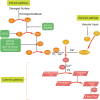Factor XI, a potential target for anticoagulation therapy for venous thromboembolism
- PMID: 36386334
- PMCID: PMC9659736
- DOI: 10.3389/fcvm.2022.975767
Factor XI, a potential target for anticoagulation therapy for venous thromboembolism
Abstract
Venous thromboembolism (VTE) is a common cause of mortality and disability in hospitalized patients, and anticoagulation is an essential therapeutic option. Despite the increasing use of direct oral anticoagulants, complications and adverse drug reactions still occur in patients with VTE. Within 5 years, 20% of patients with VTE experience recurrence, and 50% of patients with deep vein thrombosis develop post-thrombotic syndrome. Furthermore, bleeding due to anticoagulants is a side effect that must be addressed. Therefore, safer and more effective anticoagulant strategies with higher patient compliance are urgently needed. Available epidemiological evidence and animal studies have shown that factor XI (FXI) inhibitors can reduce thrombus size and loosen the thrombus structure with a relatively low risk of bleeding, suggesting that FXI has an important role in thrombus stabilization and is a safer target for anticoagulation. Recent clinical trial data have also shown that FXI inhibitors are as effective as enoxaparin and apixaban in preventing VTE, but with a significantly lower incidence of bleeding. Furthermore, FXI inhibitors can be administered daily or monthly; therefore, the monitoring interval can be longer. Additionally, FXI inhibitors can prolong the activated partial thromboplastin time without affecting prothrombin time, which is an easy and common test used in clinical testing, providing a cost-effective monitoring routine for patients. Consequently, the inhibition of FXI may be an effective strategy for the prevention and treatment of VTE. Enormous progress has been made in the research strategies for FXI inhibitors, with abelacimab already in phase III clinical trials and most other inhibitors in phase I or II trials. In this review, we discuss the challenges of VTE therapy, briefly describe the structure and function of FXI, summarize the latest FXI/activated FXI (FXIa) inhibitor strategies, and summarize the latest developments in clinical trials of FXI/FXIa inhibitors.
Keywords: abelacimab; anticoagulation therapy; direct oral anticoagulants; factor XI inhibitors; venous thromboembolism.
Copyright © 2022 Li, Liu and Wu.
Conflict of interest statement
The authors declare that the research was conducted in the absence of any commercial or financial relationships that could be construed as a potential conflict of interest.
Figures

References
-
- Konstantinides SV, Meyer G, Becattini C, Bueno H, Geersing GJ, Harjola VP, et al. . 2019 ESC Guidelines for the diagnosis and management of acute pulmonary embolism developed in collaboration with the European Respiratory Society (ERS). Eur Heart J. (2020) 41:543–603. 10.1093/eurheartj/ehz405 - DOI - PubMed
Publication types
LinkOut - more resources
Full Text Sources

